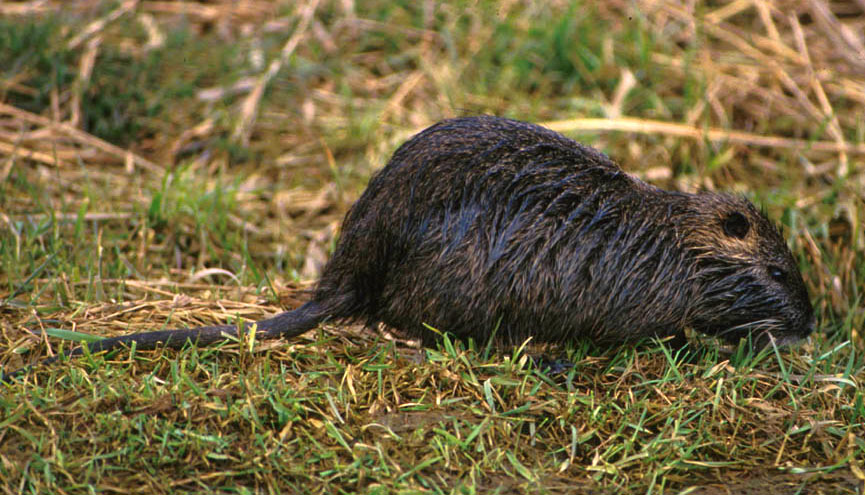Nutria, a large, semi-aquatic rodent native to South America, were brought to the United States for their fur in the 1880s. They were introduced to Oregon in the 1930s. Farming nutria fur was marketed as a quick and easy way to make money. When the nutria fur market collapsed in the late 1940s, however, thousands of nutria were released. Because of their prolific and mobile nature, the population quickly spread throughout western Oregon.
From a distance, nutria or coypu (Myocastor coypus) can be mistaken for beaver, but it is a smaller animal with a thin, pointed tail. Nutria have prominent orange incisors and are about two feet long, with fur that ranges from yellowish to dark brown. Their hind feet are webbed to facilitate swimming, and their noses, eyes, and ears are set high on their heads. Nutria live in freshwater marshes and wetlands and can adapt relatively easily to different habitats.
By the 1960s, the damage being done to marshlands by nutria in Oregon was severe. Nutria feed on native plants that hold wetland soil together. Eating these plants, in addition to burrowing, causes the banks of lakes to collapse. Nutria can also damage flood control levees and weaken the foundations of roadbeds. In addition, nutria are often carriers of pathogens and parasites, posing a health risk to both people and other animals. Nutria have become a very serious problem.
Numerous methods have been devised to control the growing population of nutria in Oregon, including feeding them raw carrots dusted with poison and setting fur traps. There were also unsuccessful efforts to adopt eating nutria meat as a way to control the surpluses.
According to the Oregon Administrative Rules (635-056-0050), nutria are on the list of prohibited species, which outlaws the importation, possession, exchange, purchase, sale, and transportation of the animal. Shooting nutria is legal outside city limits, and they can be humanely euthanized by wildlife control officers.
Despite these efforts, nutria continue to be a problem. The extensive population and the gravity of the resulting damage illustrate the challenges and problems associated with introducing non-native species to an area.
-
![]()
A nutria in the lake at Browns Ferry Park, Tualatin, 2024.
Courtesy Karen K. Johnson
-
![Nutria.]()
Nutria 2.
Nutria. Photo Jessica Rondema
-
![Nutria.]()
Nutria 1.
Nutria. Courtesy U.S. Fish & Wildlife Service
-
![]()
A nutria at the lake in Browns Ferry Park, Tualatin, 2024.
Courtesy Karen K. Johnson
Further Reading
Evans, James. About Nutria and Their Control. Denver, Colo.: U.S. Department of the Interior Bureau of Sport Fisheries and Wildlife, Aug. 1970.
Kuhn, Leo W. Oregon’s Nutria Problem: Proceedings of the 6th Vertebrate Pest Conference. Lincoln: University of Nebraska, 1974.
Larrison, Earl J. "Feral Coypus in the Pacific Northwest." The Murrelet, 24:1 (1943): 3-9.




